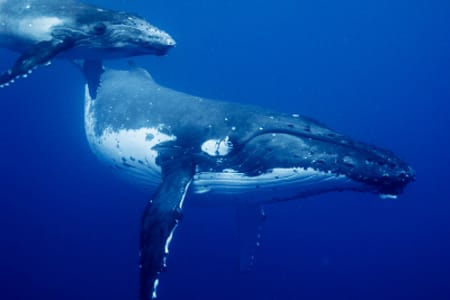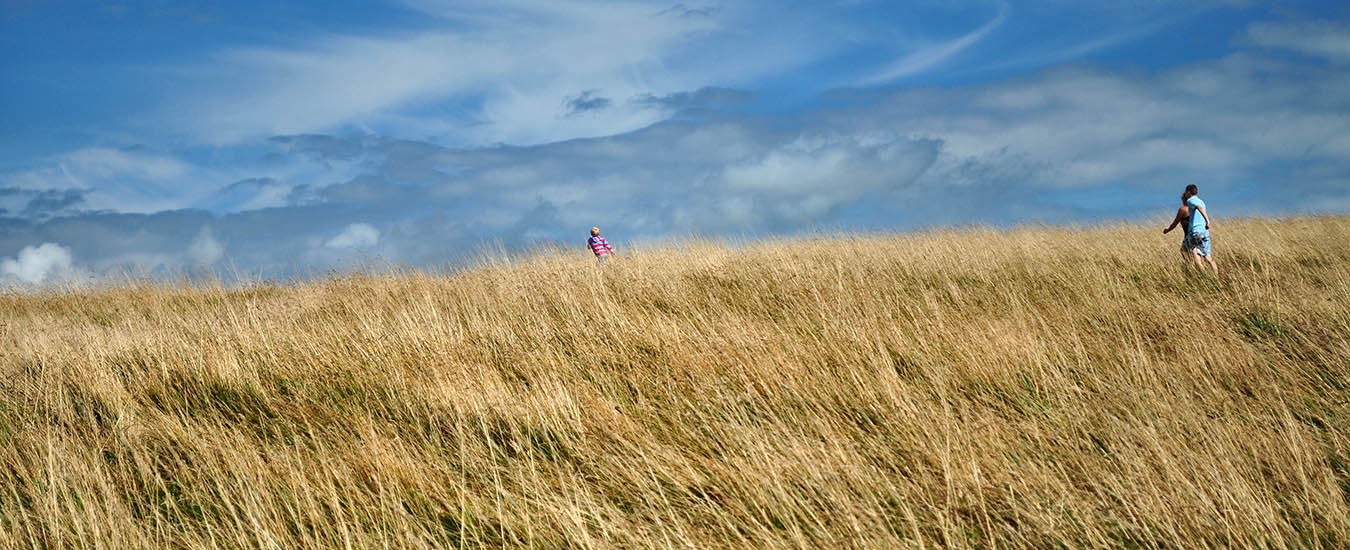Can our scientists save the whales?
One day, while Dr. Lindy Weilgart, a research associate at Dalhousie University, in Halifax, was sailing on the Indian Ocean, she put on flippers, a snorkel and mask, and jumped into the water beside a birthing sperm whale.
The one-tonne, four-metre calf that Weilgart saw being born actually swam over to her. "I'll never forget that. It's one real highlight of my life," she says. "It came within touching distance-a 10-minute-old calf and you could see so much expression in that eye: it was bright blue, inquisitive, a little fearful."
The largest toothed animal alive, the sperm whale is most recognized as the whale that shattered Captain Ahab's ship in the novel Moby Dick. Typically, it has 24 pairs of teeth; each tooth weighs a kilogram. Measuring up to 14 metres, a full-grown female sperm whale is as long as a school bus and approximately the same weight; males are twice the weight. They can dive up to a kilometre and stay down for as long as 90 minutes. When they get to the bottom of the deep ocean, they hunt giant squid.

People like Weilgart come away from such encounters steadfastly dedicated not just to their work, but also to the very survival of the planet's largest creatures, and the oceans in which they live.
A whale-any whale-is an extraordinary animal. It's that look in the eye, the capacity of that large brain to create complex societies that garners respect among people who work with them.
Many who research and advocate for whales describe close encounters - though few as dramatic as Weilgart's - early in their lives. For Hilary Moors, a PhD student working at what has become known as Dalhousie's Whitehead Lab, a group of students named after lead scientist Dr. Hal Whitehead, it was a whale-watching trip in elementary school off Digby, NS, that hooked her for life.
Tonya Wimmer, a former graduate student at the Whitehead Lab who, similar to Moors, studied northern bottlenose whales, says her moment came during a visit to MarineLand in Niagara Falls, ON, where she saw killer whales and dolphins. Wimmer is now a species conservation manager with the World Wildlife Fund of Canada as well as the president and coordinator for the Marine Animal Response Society, a group that works to disentangle whales from fishing gear and to gather data on dead and stranded whales.
Hal Whitehead's whale was a minke off Port Mouton, NS - one of the factors that led him from a degree in math to one in zoology and eventually from England to Newfoundland, where he studied humpback whales. He joined the faculty at Dalhousie in 1986 where he is now a biology professor. With more than 100 whale-related articles in scientific journals, Whitehead is a highly respected international figure.
Whitehead, Weilgart, Moors and Wimmer have spent a lot of time at sea pursuing whales, most of it on Whitehead's 40-foot sailboat, Balaena. "In some ways the ocean is the last great wilderness," says Whitehead. "I sail for weeks and never see any sign of humans. It's also very mysterious."
Many of their trips are to a 2,000-metre-deep canyon in the Scotian Shelf - 200 kilometres off the shore of Nova Scotia, east of Sable Island - called the Gully, which scientists are just beginning to explore. In 2004, the Gully was named the first Marine Protected Area on Canada's East Coast. Hal Whitehead and his colleagues can take some of the credit for this-they demonstrated that the Gully is teeming with life, including sperm whales, blue whales and dolphins.
The area also happens to be vital to the survival of the strange and rare northern bottlenose whale, a type of beaked whale.
Under Whitehead's direction, Hilary Moors gathers data from hydrophones she drops into the Gully to record the sounds of the bottlenose. Tonya Wimmer studied the movements of these whales between the Gully and two smaller, unprotected canyons nearby, the Shortland and the Haldimand. According to her data only about 160 northern bottlenose whales remain. The population was granted endangered species status largely due to the research of the Whitehead Lab.
The threats to the northern bottlenose whale and to its habitat are significant. "Their population was reduced by whaling, they're caught in fishing gear and they're potentially very vulnerable to noise," says Whitehead.
Acoustic threats to the beaked whale family come from two sources: seismic surveys and the military. The offshore petroleum industry and others use sound explosions to survey the ocean floor. The US Navy uses mid-frequency sonar in anti-submarine warfare exercises.
Weilgart says bottlenose whale bodies found on shore or at sea after these naval exercises have bubbles in their tissues… hemorrhages in the brain and heart. "Bottlenose whales can be killed within four hours of the beginning of a sonar exercise. It looks a lot like decompression sickness in humans.
"You have single animals separated by miles, yet they all strand more or less at the same time. The only cause that could effect a lot of animals over a large distance is sound."
Such deaths are strongly correlated with naval exercises, though less clearly with seismic surveys.
The threats to whales that live closer to shore, like the humpbacks off Newfoundland, are different. In the past, many humpbacks drowned or starved when they became entangled in cod traps. Dr. Jon Lien received a Lifetime Achievement Award in June 2007 from the province of Newfoundland and Labrador for his work on solving this problem. Through his Whale Release Program, he taught fishermen how to free humpback whales, and how to avoid catching them in the first place.
"He's the godfather of that kind of work," says Deborah Tobin, considered by some to be the Jane Goodall of whales. She has applied Lien's techniques, along with techniques from the Providence Center for Coastal Studies, in Rhode Island, to saving the population of about 350 North Atlantic right whales remaining in the Bay of Fundy. As with bottlenose whales, the whaling industry brought this population - so named because they were the "right whale" to hunt-close to collapse, making it one of the world's most endangered animals.
Like Lien, Tobin has tried to solve the entanglement problem. "The work is so compelling and difficult," she says. In spite of her enormous efforts, North Atlantic right whales continue to die in fishing gear.
But entanglement isn't the only danger right whales face in a post-whaling world. More right whales die in ship collisions than by any other means. The North Atlantic right whale summer feeding grounds happened to lie in the path of a major Bay of Fundy shipping lane, and ship strikes were so common that the whales were identified by scab-like encrustations or scars formed after collisions with ships.
There's good news on this front. In June 2003, the shipping lane that has killed so many right whales was altered. Dr. Moira Brown, a scientist at the Canadian Whale Institute at Wilson's Beach, NB, and also at the New England Aquarium, in Boston, can take much of the credit for spearheading the initiative. A colleague of Brown's at the New England Aquarium, Dr. Rosalind Rolland, wants to solve another problem facing North Atlantic right whales-why they aren't reproducing in numbers large enough to sustain the population. To her, it's a population that doesn't look healthy at times.
"After seeing the right whales in the Auckland Islands," Rolland says, "I have a whole different perception of what a healthy right whale looks like."
And yet, the northern species lives in one of the most fertile ocean ecosystems anywhere. Rolland says the Bay of Fundy is unbelievably diverse: "It's one of the most spectacular places on Earth. This is the Serengeti of the ocean."
Enter Bob and Fargo. Wild animal feces can reveal a great deal about the health of individuals and populations. So Rolland had a couple of drug-sniffing dogs, Bob and Fargo, trained to scout out whale poop. Bob has retired, but with more funding Fargo will go back to sea with her in search of right whale feces.
"He's one of the world's great dogs," Rolland says, and far more effective than humans at finding smelly stuff. "He's scented samples up to a nautical mile away."
Considering body factors - such as a roll of fat just behind the blowhole, a good indicator of body stores-and information gleaned from the feces, Rolland has made some alarming discoveries. She's found high numbers of parasites in right whales that are only known in land animals such as domestic cats, but it's unclear that such findings will solve the mystery.
One thing is clear, however: human activity might yet drive North Atlantic right whales into extinction. "They're swimming through an environment with a lot of shipping, a lot of fishing gear, a huge amount of noise, where there's a lot of urban runoff, of petroleum products, chemicals and sewage effluent."
Rolland and the others agree that there's a great deal more work to do if there's any hope of guaranteeing the survival of the whales-but they disagree on the chances for success.
The establishment of the Gully as a Marine Protected Area is a huge step forward for the northern bottlenose whale, says Whitehead. "The priority now is to make sure the other two canyons they use heavily are protected against noise and fishing gear," he adds. "We don't really know how bad the problem is for any species, let alone for the whole ecosystem, so we need to set up networks of marine protected areas."
Lindy Weilgart is not as optimistic. Problems like noise disturbance, for example, may be easy to solve with changes in equipment and location of activity, but her involvement in two lawsuits against the US Navy has jaded her. She says that because the Navy funds 50 per cent of marine mammal research worldwide, things are not going to change any time soon. She calls this type of funding "hush money"-scientists who receive it are reluctant to speak out against Navy practices like using sonar in anti-submarine warfare exercises.
Aside from specific threats to particular whale species, the ocean environment is compromised in many different ways, she says. "You have the bleaching of coral reefs, overfishing, 90 per cent of sharks gone, biotoxic algae, the bycatch. It's not exactly a rosy picture. The oceans are definitely dying. How fast they're dying and how reversibly is still a question, but they're in very bad shape. I don't see how whales are going to manage."
Rolland says she has to be an optimist, or she couldn't do what she does. "Right whales are probably very long-lived animals. They've been through a lot of large-scale environmental changes, including many Ice Ages. They have to be very resilient to have survived as long as they have.
"We have seen an improvement in calf production in the last few years… also, various initiatives such as moving the shipping lanes are extremely encouraging because that occurred with the help of Irving Oil. When scientists, policy-makers and industry come to solutions together, that's the ideal thing."
When Rolland is asked what she would give for the survival of the North Atlantic right whale, she says, "anything." But that doesn't mean she's going to quit her job as a scientist and work full-time as an activist. Like Hal Whitehead, Rolland says she best serves whales by continuing her research.
PhD student Hilary Moors feels the same. Jon Lien has retired, making way for young activists like Tonya Wimmer, who decided to leave academia and work-full time on conservation. Moira Brown has managed to combine science with action to reduce human impact on whales.
Whatever course whale scientists and activists take, their passion and motivation is clear: to save the whales.
